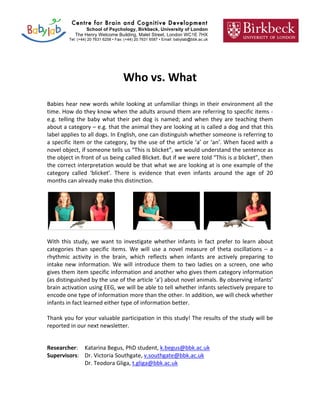Birkbeck Babylab Who vs What study info sheet
•
1 like•247 views
Parental info sheet for Katarina Begus' study at Birkbeck Babylab
Report
Share
Report
Share
Download to read offline

Recommended
Recommended
Natural epistemology or evolved metaphysics — developmental evidence for earl...

Natural epistemology or evolved metaphysics — developmental evidence for earl...SPK División Gráfica Digital de Surpack S.A.
More Related Content
Similar to Birkbeck Babylab Who vs What study info sheet
Natural epistemology or evolved metaphysics — developmental evidence for earl...

Natural epistemology or evolved metaphysics — developmental evidence for earl...SPK División Gráfica Digital de Surpack S.A.
Similar to Birkbeck Babylab Who vs What study info sheet (16)
John A. Pollock - How People Learn: Stories from Transmedia for STEM and Heal...

John A. Pollock - How People Learn: Stories from Transmedia for STEM and Heal...
Natural epistemology or evolved metaphysics — developmental evidence for earl...

Natural epistemology or evolved metaphysics — developmental evidence for earl...
AQA Psychology A Level Revision Cards - Cognition And Development Topic

AQA Psychology A Level Revision Cards - Cognition And Development Topic
Recently uploaded
Recently uploaded (20)
SaffronCrocusGenomicsThessalonikiOnlineMay2024TalkOnline.pptx

SaffronCrocusGenomicsThessalonikiOnlineMay2024TalkOnline.pptx
Fun for mover student's book- English book for teaching.pdf

Fun for mover student's book- English book for teaching.pdf
X-rays from a Central “Exhaust Vent” of the Galactic Center Chimney

X-rays from a Central “Exhaust Vent” of the Galactic Center Chimney
Nanoparticles for the Treatment of Alzheimer’s Disease_102718.pptx

Nanoparticles for the Treatment of Alzheimer’s Disease_102718.pptx
dkNET Webinar: The 4DN Data Portal - Data, Resources and Tools to Help Elucid...

dkNET Webinar: The 4DN Data Portal - Data, Resources and Tools to Help Elucid...
Mining Activity and Investment Opportunity in Myanmar.pptx

Mining Activity and Investment Opportunity in Myanmar.pptx
Information science research with large language models: between science and ...

Information science research with large language models: between science and ...
ANITINUTRITION FACTOR GYLCOSIDES SAPONINS CYANODENS

ANITINUTRITION FACTOR GYLCOSIDES SAPONINS CYANODENS
Efficient spin-up of Earth System Models usingsequence acceleration

Efficient spin-up of Earth System Models usingsequence acceleration
Birkbeck Babylab Who vs What study info sheet
- 1. Centre for Brain and Cognitive Development School of Psychology, Birkbeck, University of London The Henry Welcome Building, Malet Street, London WC1E 7HX Tel: (+44) 20 7631 6258 • Fax: (+44) 20 7631 6587 • Email: babylab@bbk.ac.uk Who vs. What Babies hear new words while looking at unfamiliar things in their environment all the time. How do they know when the adults around them are referring to specific items -‐ e.g. telling the baby what their pet dog is named; and when they are teaching them about a category – e.g. that the animal they are looking at is called a dog and that this label applies to all dogs. In English, one can distinguish whether someone is referring to a specific item or the category, by the use of the article ‘a’ or ‘an’. When faced with a novel object, if someone tells us “This is blicket”, we would understand the sentence as the object in front of us being called Blicket. But if we were told “This is a blicket”, then the correct interpretation would be that what we are looking at is one example of the category called ‘blicket’. There is evidence that even infants around the age of 20 months can already make this distinction. With this study, we want to investigate whether infants in fact prefer to learn about categories than specific items. We will use a novel measure of theta oscillations – a rhythmic activity in the brain, which reflects when infants are actively preparing to intake new information. We will introduce them to two ladies on a screen, one who gives them item specific information and another who gives them category information (as distinguished by the use of the article ‘a’) about novel animals. By observing infants’ brain activation using EEG, we will be able to tell whether infants selectively prepare to encode one type of information more than the other. In addition, we will check whether infants in fact learned either type of information better. Thank you for your valuable participation in this study! The results of the study will be reported in our next newsletter. Researcher: Katarina Begus, PhD student, k.begus@bbk.ac.uk Supervisors: Dr. Victoria Southgate, v.southgate@bbk.ac.uk Dr. Teodora Gliga, t.gliga@bbk.ac.uk
